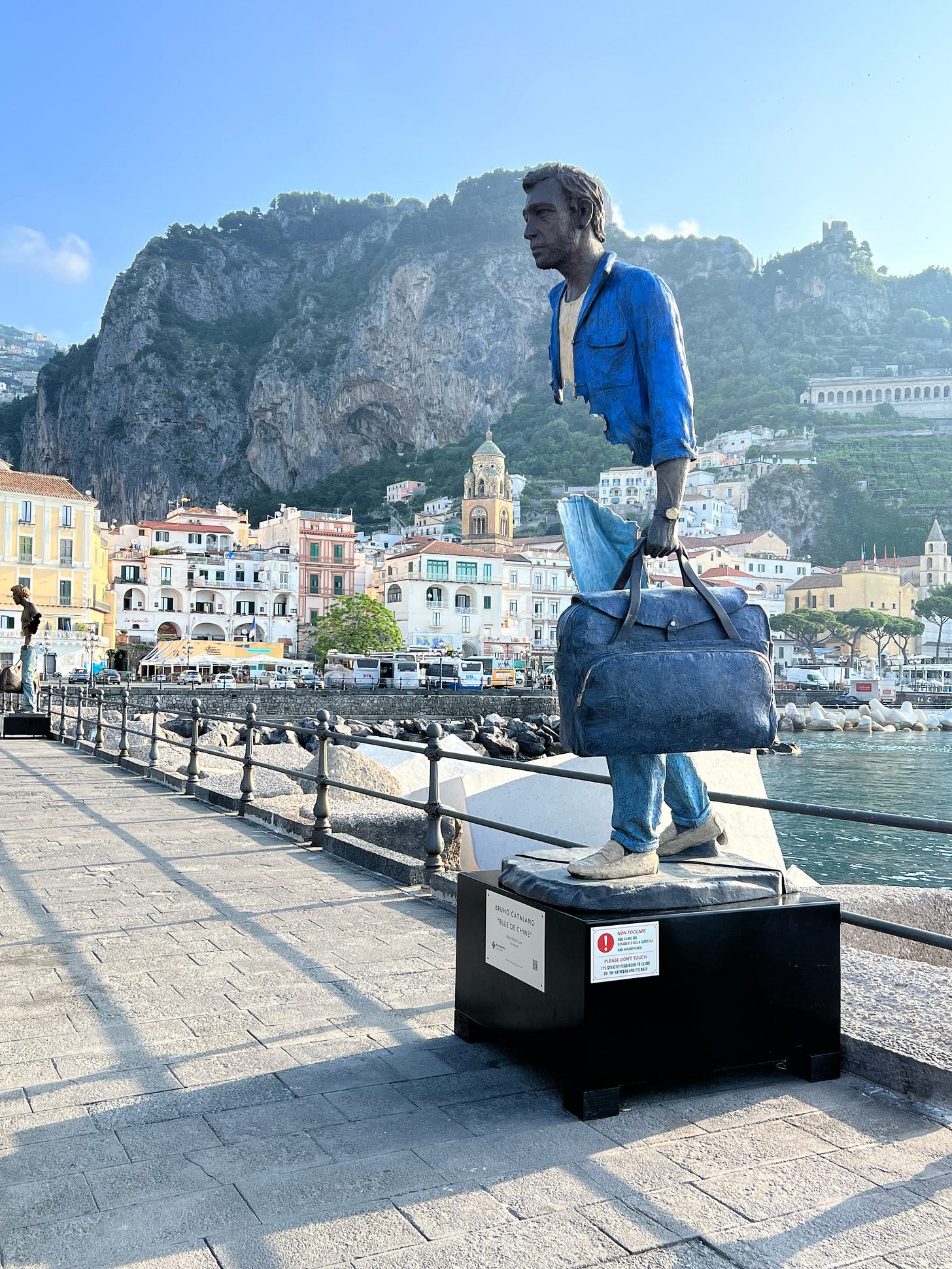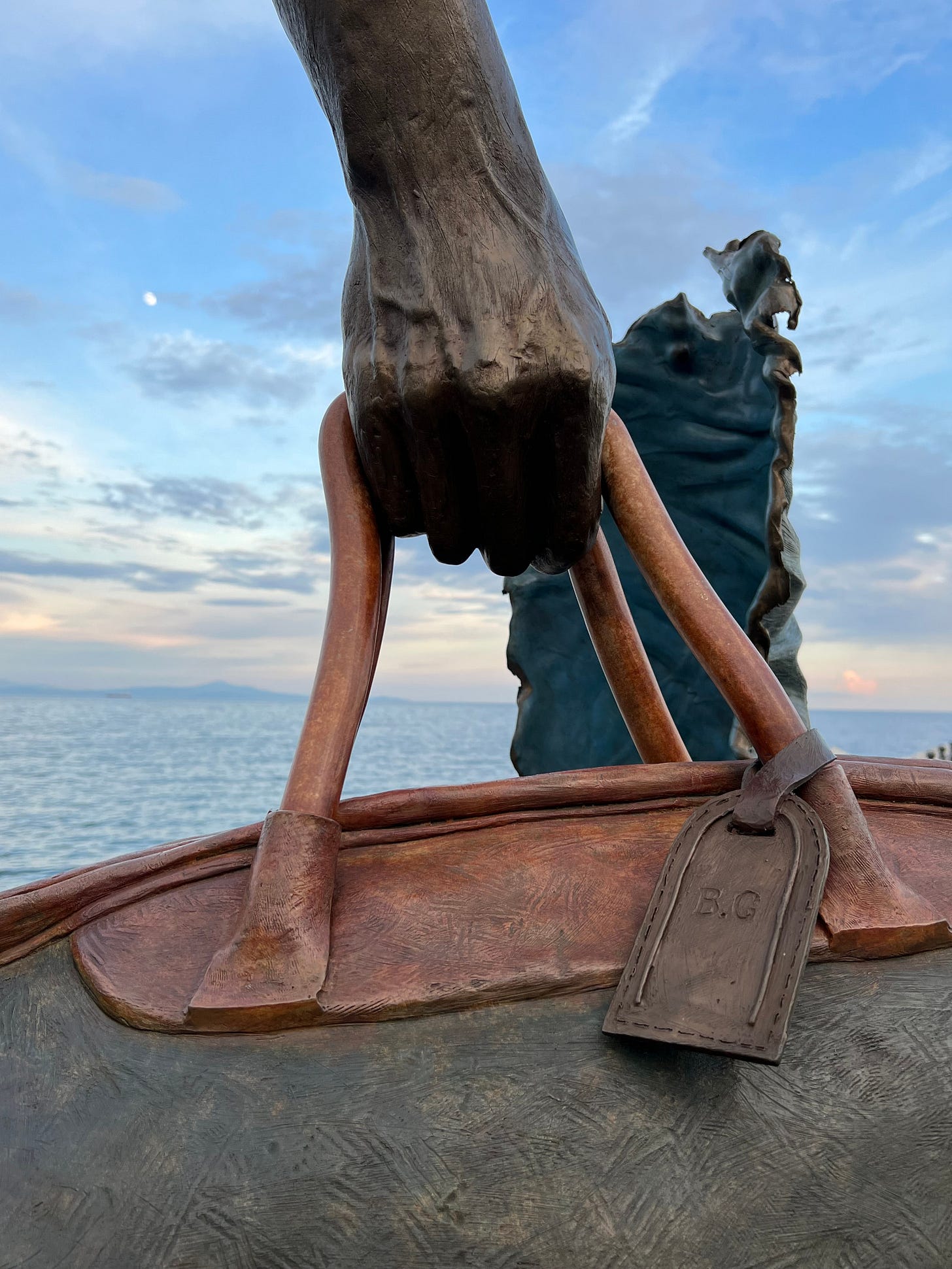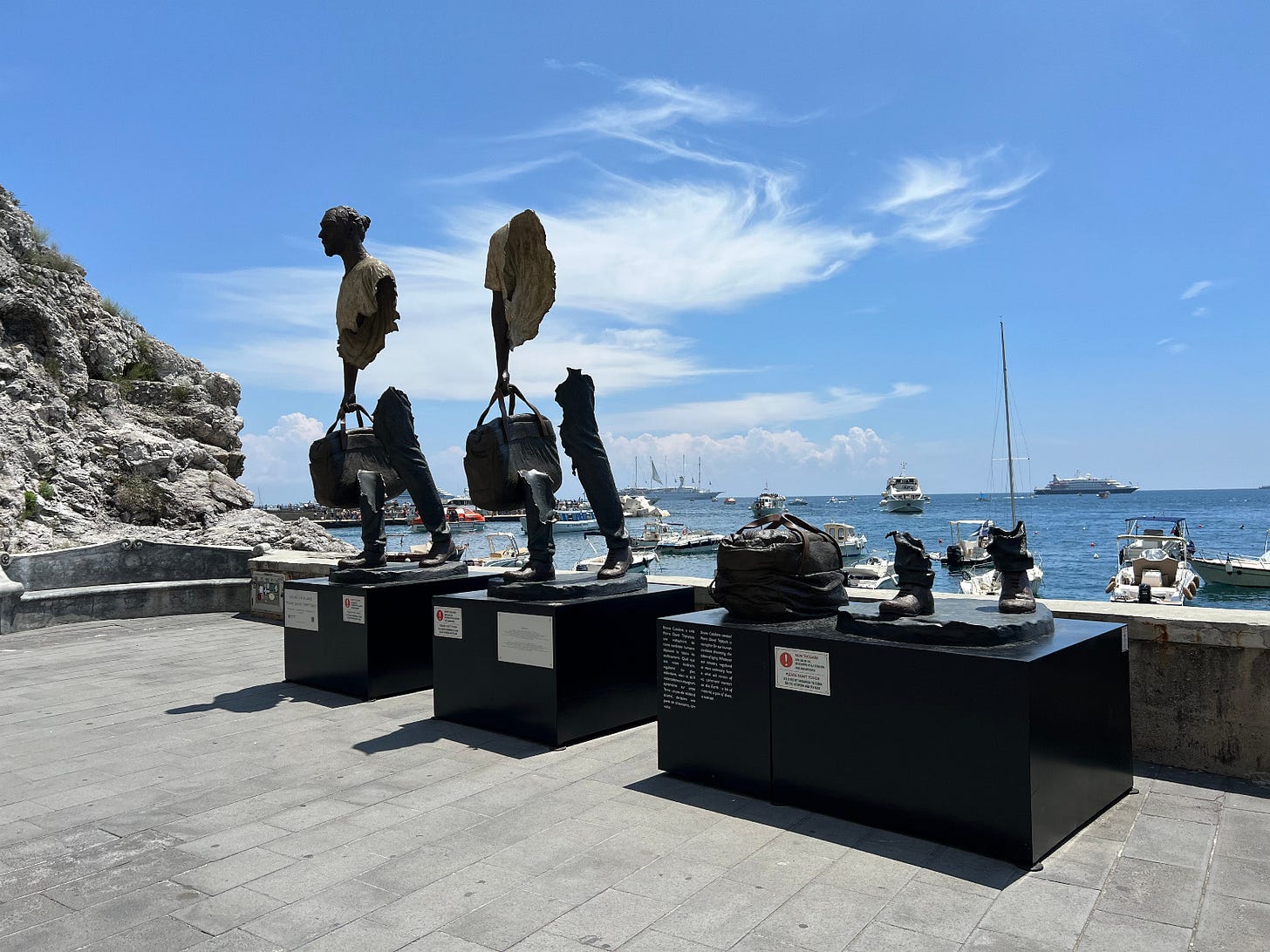A New Type of Traveler Arrives in Amalfi
See Bruno Catalano's monumental bronze sculptures in Amalfi - now through September 30, 2023.
If you’re visiting Amalfi this summer, you’ll have the chance to encounter a very different sort of traveler. Four large scale sculptures called Les Voyageurs (The Travelers) by the French-Italian artist Bruno Catalano are on display along the waterfront of Amalfi until September 30, 2023. With Amalfi as a backdrop, the bronze statues are a captivating sight placed along the Molo Domenico Cassone—what we locally call the Pennello pier—and nearby on Lungomare dei Cavalieri in front of the Hotel La Bussola.
In a place like Amalfi, where so many people have come and gone—and continue to visit from around the world—these monumental travelers seem somehow right at home. Enza Cobalto, the Cultural Advisor for the Comune di Amalfi and a driving force for this art installation in Amalfi, said:
«This open air exhibition is a tribute to the people of Amalfi in the world - those of yesterday and today. Women and men who have left the perfect places of childhood for work or because they are forced by contingent situations. Like the natives who left for distant lands at the beginning of the twentieth century, their suitcases were not only loaded with a few personal effects but with many hopes placed in those lands that welcomed them and where their closest relatives continue to live today. Everyone, in the place where he lives today, has transferred his love for Amalfi and the Amalfi Coast, proudly nurturing that never dormant sense of belonging. The suitcases of Catalano's travelers recall not only emigration but also the ability of the Amalfitans to maintain commercial relations, along the path traced by the great merchants of the maritime republic."1
The Travelers represent journey as well as emigration - something Bruno Catalano has experienced firsthand. Born in Morocco in 1960, his family has journeying it its DNA. The Franco-Italian family roots trace from Spain to Sicily to North Africa. Then at 10 years old, Catalano moved with his family to Marseille, France. Trained as an electrician, he set off across the Mediterranean working on ships. Port cities have a certain magic of amalgamation to them, and Catalano’s journey eventually led him to sculpture.
Catalano describes the inspiration for this monumental works: “Originally from Morocco, I too have traveled with suitcases full of memories that I represent so often in my works. They contain not only images, but also my experience, my desires: my origins in movement.”2
The distinctive torn out central section of The Travelers series came about as a sort of happy creative accident. Much like the happy accidents and the chance encounters that happen while traveling, in 2004 a casting mistake created a breach in the center of a statue and the result has since become one of the defining elements of the series.
As I walk by the statues in Amalfi, I realize more every day that they are pieces that invite a closer look, as your eye tries to figure out how the massive statue stands while missing its core. In the end, it’s the baggage—different for each figure—that “makes the link between the thinking head and the walking feet.”
It’s preciscely that very connection between who we are and where our feet carry us that begs closer inspection. The very heart of each sculpture is missing. Passing by early in the morning, I wonder if it’s because whether or not we want to we seem to leave peices of ourselves everywhere we go. And sometimes—as is the case with so many Italians who emigrated from the Amalfi Coast—we have to leave the place that means the most. Does that eventually leave us with nothing left or does it rather create more space for new experiences, new loves, new places?
It’s the questions that come to mind, which are surely different for everyone who stops to gaze up at The Travelers, that makes these statues so intriguing. And at a time when the season is busy and everything is moving too fast, they are an invitation to stop and reflect on where exactly we’re going.
Would you like to meet The Travelers?
Hubert
This striking and solid figure stands barefoot, bag grasped firmly, and with a hand casually slipped in a pocket. Dressed only in a pair of jeans and with thick wavy hair, Hubert seems to have paused just a moment to take a look around where his most recent travels have taken him. This time he has arrived in Amalfi.
Blue de Chine
Blue de Chine is dedicated to “all the workers who have travelled from faraway places to find a job.” The blue patina suggests worker and mariner outfits and also Catalano’s personal experience of arriving in Marseille with only one suitcase. Viewed from just the right angle, I love how you can see the 15th-century Torre dello Ziro right through him. These sculptures take on something of their landscape, changing depending which angle you’re viewing them from and in which location. His works “are traversed, if not innervated, by the landscapes that host them.”
Simone
The large sculpture called Simone was created especially for this installation in Amalfi and depicts a Venetian man dressed in a suit and tie and carrying a large suitcase. His style is distincitively Italian and his gaze is calm and confident as he strides forward.
Pierre David Triptyque
This triptych is Catalano’s monumental figure in three pieces. The expansion from the planted feet and bag sitting on the ground on the right to the central figure holding the bag but missing the head and finally to the left figure ready to embark on a journey seems to tell the story of growth and experiences. According to Catalano it is a “metaphor for our human condition thwarting the taboo of aging.”
The Travelers by Bruno Catalano are on display in Amalfi now through September 30, 2023 and the installation is a collaboration between the Comune of Amalfi and the Ravagnan Gallery in Venice.
“Questa mostra en plein air vuole essere un omaggio agli Amalfitani nel mondo – dice la consigliera delegata alla cultura Enza Cobalto – Quelli di ieri e di oggi. Donne e uomini che hanno lasciato i luoghi perfetti dell’infanzia per lavoro o perché costretti da situazioni contingenti. Come gli oriundi che partirono verso terre lontane a inizio Novecento. Le loro valigie erano non solo cariche di pochi effetti personali ma di tante speranze riposte in quelle terre che li ospitarono e in cui oggi continuano a vivere i loro congiunti più stretti. Ciascuno, nei luoghi in cui oggi vive, ha trasferito l’amore per Amalfi e per la Costiera alimentando con orgoglio quel senso di appartenenza mai sopito. Le valigie dei viaggiatori di Catalano ricordano non solo l’emigrazione ma anche la capacità degli Amalfitani, di intrattenere rapporti commerciali, lungo solco tracciato dai grandi mercanti della repubblica marinara.” (Comune di Amalfi)
“Originaire du Maroc, j’ai moi aussi voyagé avec des valises pleines de souvenirs que je représente si souvent dans mes œuvres. Elles contiennent non seulement des images, mais aussi mon vécu, mes désirs : mes origines en mouvement.” (Les Voyageurs de Bruno Catalano)












I wonder why they are all men?
I hope I get there by the end of September! So looking forward to moving into my new home - I love how art and art installations are such a huge part of each of the communes on the Coast.